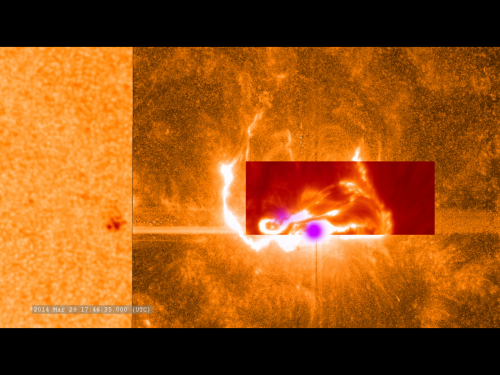International team capture detailed footage of an X-class solar flare

(Phys.org) —Astrophysicists recently won the 'solar science lottery' as they were observing the skies just as one of the most energetic and rarest of solar eruptions took place. The international team, which included researchers from Trinity College Dublin, was able to record the rare event from multiple telescopes to build the most detailed picture yet of an 'X-class solar flare'.
From time to time, the Sun bombards the Earth with enormous blobs of solar plasma that are hurled toward us at speeds upward of 1000 kilometres per second. Upon impacting the Earth, the effects of these solar storms may include the polar aurorae (e.g. the northern lights), satellite malfunctions, rerouting of air traffic, and blackouts of radio, GPS, and power grids. Solar storms can be observed as solar flares, with the X-class flare being the most extreme. An X-class flare resulted in a 'geomagnetic storm' that caused a nine-hour blackout in Quebec, Canada, in 1989, while the aurorae were so pronounced that some people even worried that a nuclear strike had been launched.
On 29 March 2014, Dr Paul Higgins (Irish Research Council Research Fellow in Trinity's Astrophysics Research Group in the School of Physics) and an international group of scientists obtained the most detailed observations to date of an X-class solar flare. The huge solar eruption was recorded simultaneously from telescopes on the ground and in space. Dr Higgins is a flare prediction expert and assisted the New Mexico-based team by making an accurate forecast of the event. He also initiated a 'Major Flare Watch' hours beforehand, which put observatories across the globe on high-alert.
Dr Higgins said: "No one really knows what triggers these large flares to occur, partially because very few have been studied in detail. X-class flares occur less than once per month on average, and a year or more can pass without any occurring at all. Also, the core of the flare is limited to a 'tiny' area on the Sun (a few times the size of the Earth) and the field-of-view of many telescopes is equally small, so it is incredibly difficult to catch one of these events in action."
Led by Dr Lucia Kleint (Bay Area Environmental Research Institute), the team was observing the Sun at the National Solar Observatory (NSO) in New Mexico and managed to record the rare event with multiple instruments at the ground-based Dunn Solar Telescope. The team was able to measure the magnetic fields within the erupting structure, which is a critical part of the flare process.
Dr Higgins added: "This dataset provides unprecedented detail of the solar flare's evolution, from its onset in a region of just a few thousand kilometres right through its expansion into interplanetary space. By studying such large and rare events in detail, scientists hope to learn how to better predict future flare occurrences and protect our infrastructure and the lives of our pilots and astronauts."
Astronomer and co-observer Dr Kevin Reardon (National Solar Observatory) said: "This observation is unique – so rarely do all the conditions come together. Studying these data should give us a glimpse of what to expect when we try to capture these flares with much better spatial resolution using the twenty-five-times bigger Daniel K. Inouye Solar Telescope (DKIST) currently being built on Maui, Hawaii."
Provided by Trinity College Dublin





















